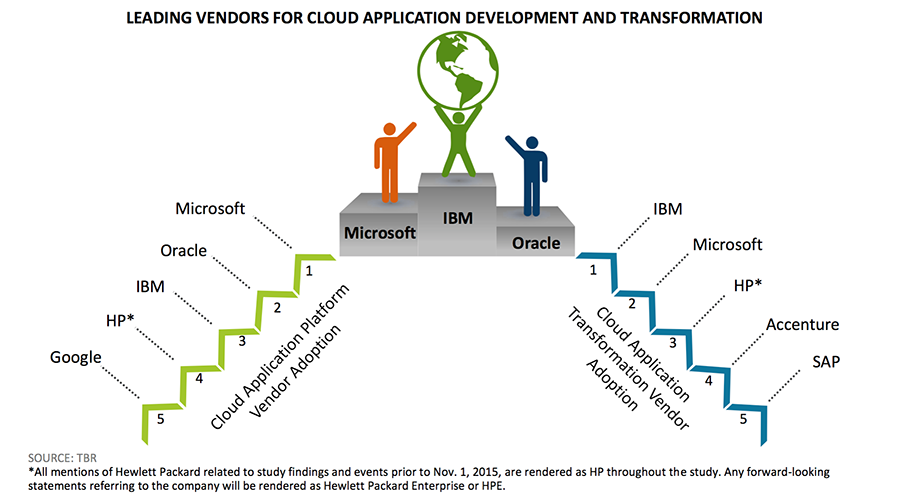 NEWS
NEWS
 NEWS
NEWS
 NEWS
NEWS
Migrating existing applications to the cloud can be complicated and cause unease. Will data be lost during the transition? Will employees need to be trained on new systems? Will processes change?
It makes sense, then, that companies turn to cloud providers that also provide services to assist with the transition, as a recent report from Technology Business Research Inc. (TBR) found.
In Cloud Customer Research Topical Report: New vs. Legacy Applications, which surveyed nearly 700 enterprises, TBR found that when it comes to selecting a cloud application transformation vendor, companies turn to providers that include consulting and integration expertise. Other important traits that they look for: having a broad portfolio that includes in-house services capabilities and application portability and flexibility options such as containerization.
Of the top three vendors respondents turn to, IBM was at the top of the list with 32 percent. Microsoft was second with 21 percent, and Hewlett Packard Enterprise (HPE) was third with 20 percent.
The two main reasons customers chose them: they have consultants and advisors to help customers plan their roadmap to the cloud, and they have big practices around enterprise applications, said Cassandra Mooshian, senior cloud analyst at TBR.
Customers are looking for one vendor to do the entire process: advise, transform and implement, she said. And IBM fits that bill more than the other vendors.
“IBM leads other vendors in application transformation because it provides customers with a broad portfolio, complete with a dedicated services arm, that allows it to cater to individual enterprise needs,” Mooshian said.
Looking at overall cloud providers, respondents said they want a provider that has a strong presence across all geographies; a variety of delivery methods, including public and private cloud; and legacy application choices as well as cloud application choices.
“Vendors with strong legacy and cloud businesses, such as SAP and Oracle, enable customers to bring their existing application to the cloud without downtime, changes in look and feel, or disruption. This is a relatively easy transition for enterprise employees in terms of interface and training because the solution does not change; only the delivery method shifts,” Mooshian wrote in the report.
The leading cloud development platform vendors—Microsoft, Oracle and IBM— won high satisfaction scores because their platforms provide developers with application portability and flexibility, integration between other applications from the same vendor and application program interface capabilities that extend to other vendors.
Features they offer, such as containers, application marketplaces and tools that allow business users to develop applications, all improve the developer experience, Mooshian said.
Further, the top three leading cloud platform vendors allow developers to build applications in hybrid platform as a service (PaaS), with options to develop, test and run in a private or public environment, or in a combination of the two. IBM, for example, enables hybrid cloud application creation with its behind-the-firewall-application development solution, Bluemix Local. And Microsoft Azure has local deployments in addition to public and private versions.
Microsoft, Oracle and IBM are also seen as having “deep and broad expertise across on-premises and cloud environments, giving customers a one-stop shop for their migration needs.”
Having on-premise and cloud environments puts customers at ease, Mooshian said. They feel comfortable knowing the vendor understands the ins and outs of both—that they can handle whatever happens in either environment.
The most sought after way companies are bridging traditional and cloud environments is through Bring Your Own License (BYOL). It is far more popular than transforming to a cloud platform or purchasing new cloud services that are cloud-native from the start.
With BYOL, a customer maintains its contract with a vendor while gaining the efficiencies of running the license in a cloud delivery method. For example, Microsoft customers can bring existing Windows Server licenses to Azure.
These customers may be satisfied with the vendor solutions their companies have been using on-premise and simply want to use the same solutions delivered via cloud for scale and consistency of data, as well as look and feel, Mooshian said. This is particularly true for mission- critical workloads such as ERP that span departments and require high availability.
Support our open free content by sharing and engaging with our content and community.
Where Technology Leaders Connect, Share Intelligence & Create Opportunities
SiliconANGLE Media is a recognized leader in digital media innovation serving innovative audiences and brands, bringing together cutting-edge technology, influential content, strategic insights and real-time audience engagement. As the parent company of SiliconANGLE, theCUBE Network, theCUBE Research, CUBE365, theCUBE AI and theCUBE SuperStudios — such as those established in Silicon Valley and the New York Stock Exchange (NYSE) — SiliconANGLE Media operates at the intersection of media, technology, and AI. .
Founded by tech visionaries John Furrier and Dave Vellante, SiliconANGLE Media has built a powerful ecosystem of industry-leading digital media brands, with a reach of 15+ million elite tech professionals. The company’s new, proprietary theCUBE AI Video cloud is breaking ground in audience interaction, leveraging theCUBEai.com neural network to help technology companies make data-driven decisions and stay at the forefront of industry conversations.